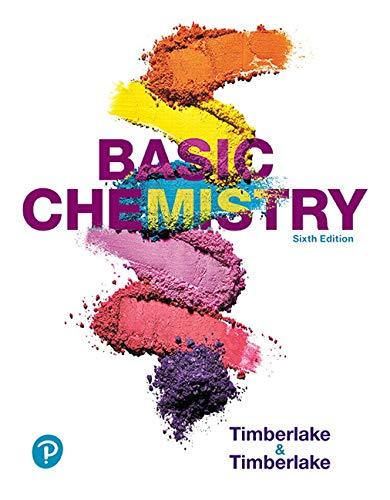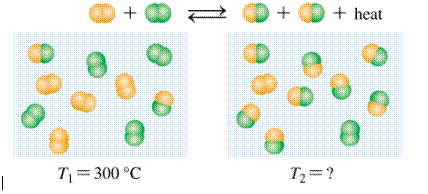
Basic Chemistry Plus Mastering Chemistry With Pearson Etext -- Access Card Package (6th Edition)
6th Edition
ISBN: 9780134983783
Author: Karen C. Timberlake
Publisher: PEARSON
expand_more
expand_more
format_list_bulleted
Concept explainers
Question
Chapter 13, Problem 57UTC
Interpretation Introduction
Interpretation:
‘Temperature of product is lower or greater than reactant’ should be identified.
Concept introduction:
Equilibrium is the condition at which the rate of formation of product is equal to rate of disappearance of reactant.
Exothermic reaction is the reaction which liberates energy and the temperature of the product is lower than reactants to proceed the reaction.
Given:

Expert Solution & Answer
Want to see the full answer?
Check out a sample textbook solution
Students have asked these similar questions
Which of the following is true for a particular reaction if ∆G° is -40.0 kJ/mol at 290 K and –20.0 kJ/mol at 390 K?
What is the major product of the following reaction?
O
O
OH
OH
1. BH
2. H₂O₂, NaOH
OH
OH
Draw the products formed when each ester is hydrolyzed with water and sulfuric acid.
Chapter 13 Solutions
Basic Chemistry Plus Mastering Chemistry With Pearson Etext -- Access Card Package (6th Edition)
Ch. 13.1 - Prob. 1PPCh. 13.1 - Prob. 2PPCh. 13.1 - In the following reaction, what happens to the...Ch. 13.1 - Prob. 4PPCh. 13.1 - Prob. 5PPCh. 13.1 - Prob. 6PPCh. 13.2 - What is meant by the term reversible reaction?Ch. 13.2 - Prob. 8PPCh. 13.2 - Which of the following are at equilibrium? a. The...Ch. 13.2 - Which of the following are not at equilibrium? a....
Ch. 13.2 - 13.11 The following diagrams show the chemical...Ch. 13.2 - Prob. 12PPCh. 13.3 - Write the equilibrium expression for each of the...Ch. 13.3 - Prob. 14PPCh. 13.3 - Prob. 15PPCh. 13.3 - Prob. 16PPCh. 13.3 - What is the numerical value of Kc for the...Ch. 13.3 - What is the numerical value of Kc for the...Ch. 13.3 - What is the numerical value of Kc for the...Ch. 13.3 - What is the numerical value of Kc for the...Ch. 13.3 - Prob. 21PPCh. 13.3 - Identify each of the following as a homogeneous or...Ch. 13.3 - Prob. 23PPCh. 13.3 - Prob. 24PPCh. 13.3 - Prob. 25PPCh. 13.3 - What is the numerical value of Kc for the...Ch. 13.4 - Prob. 27PPCh. 13.4 - Prob. 28PPCh. 13.4 - Indicate whether each of the following equilibrium...Ch. 13.4 - Indicale whether each of the following equilibrium...Ch. 13.4 - Prob. 31PPCh. 13.4 - The numerical value of the equilibrium constant,...Ch. 13.4 - Prob. 33PPCh. 13.4 - The numerical value of the equilibrium constant,...Ch. 13.5 - In the lower atmosphere, oxygen is converted to...Ch. 13.5 - Prob. 36PPCh. 13.5 - Hydrogen chloride can be made by reacting hydrogen...Ch. 13.5 - When heated, carbon monoxide reacts with water to...Ch. 13.5 - Use the following equation for the equilibrium of...Ch. 13.5 - Use the following equation for the equilibrium of...Ch. 13.5 - Prob. 41PPCh. 13.5 - Prob. 42PPCh. 13.6 - For each of the following slightly soluble ionic...Ch. 13.6 - For each of the following slightly soluble ionic...Ch. 13.6 - Prob. 45PPCh. 13.6 - Prob. 46PPCh. 13.6 - A saturated solution of silver carbonate, Ag2CO3 ,...Ch. 13.6 - Prob. 48PPCh. 13.6 - Calculate the molar solubility, S , of CuI if it...Ch. 13.6 - Calculate the molar solubility, S , of SnS if it...Ch. 13.6 - The CO2 level in the atmosphere has increased over...Ch. 13.6 - Prob. 52PPCh. 13 - Write the equilibrium expression for each of the...Ch. 13 - Write the equilibrium expression for each of the...Ch. 13 - Prob. 55UTCCh. 13 - Would the equilibrium constant, Ke , for the...Ch. 13 - Prob. 57UTCCh. 13 - Prob. 58UTCCh. 13 - Prob. 59APPCh. 13 - Prob. 60APPCh. 13 - For each of the following reactions, indicate if...Ch. 13 - For each of the following reactions, indicate if...Ch. 13 - Consider the reaction: (13.3) 2NH3(g)N2(g)+3H2(g)...Ch. 13 - Prob. 64APPCh. 13 - Prob. 65APPCh. 13 - Prob. 66APPCh. 13 - Prob. 67APPCh. 13 - According to Le Châtelier's principle, does the...Ch. 13 - Prob. 69APPCh. 13 - Prob. 70APPCh. 13 - The numerical value of the equilibrium constant,...Ch. 13 - The numerical value of the equilibrium constant,...Ch. 13 - For each of the following slightly soluble ionic...Ch. 13 - For each of the following slightly soluble ionic...Ch. 13 - Prob. 75APPCh. 13 - Prob. 76APPCh. 13 - Prob. 77APPCh. 13 - Prob. 78APPCh. 13 - What is the molar solubility, S , of CdS if it has...Ch. 13 - Prob. 80APPCh. 13 - Prob. 81CPCh. 13 - Prob. 82CPCh. 13 - Prob. 83CPCh. 13 - Indicate how each of the following will affect the...Ch. 13 - Prob. 85CPCh. 13 - Prob. 86CPCh. 13 - Prob. 87CPCh. 13 - Prob. 88CP
Knowledge Booster
Learn more about
Need a deep-dive on the concept behind this application? Look no further. Learn more about this topic, chemistry and related others by exploring similar questions and additional content below.Similar questions
- Draw the products of the hydrolysis reaction between the ester molecule and water. Determine the products of the following reaction.arrow_forwardWhat is the unsaturation number for compounds with the formula C₂H₁₂Cl₂? O õ õ o o 4 3arrow_forwardIndicate the product obtained (formula). F3C. CF3 Br NH2 NH OMe K2CO3, DABCO, DMFarrow_forward
- What are the missing intermediates 1, 2, and 3? Please include a detailed explanation explaining the steps of malonic ester synthesis. Please include drawings of the intermediates and how they occur.arrow_forwardThe following intermediates are to proceed by acetoacetic ester synthesis. What are intermediates 1 and 2 plus the final product 3? Please include a detailed explanation and drawings of the intermediates and how they occurred.arrow_forwardThe chemical formula of "benzimidazole E" is C7H6N2. Draw it.arrow_forward
arrow_back_ios
SEE MORE QUESTIONS
arrow_forward_ios
Recommended textbooks for you
 Chemistry: Principles and PracticeChemistryISBN:9780534420123Author:Daniel L. Reger, Scott R. Goode, David W. Ball, Edward MercerPublisher:Cengage Learning
Chemistry: Principles and PracticeChemistryISBN:9780534420123Author:Daniel L. Reger, Scott R. Goode, David W. Ball, Edward MercerPublisher:Cengage Learning

Chemistry: Principles and Practice
Chemistry
ISBN:9780534420123
Author:Daniel L. Reger, Scott R. Goode, David W. Ball, Edward Mercer
Publisher:Cengage Learning